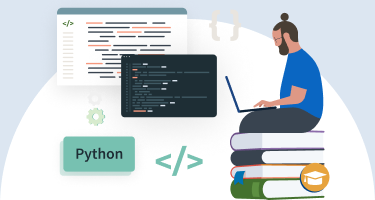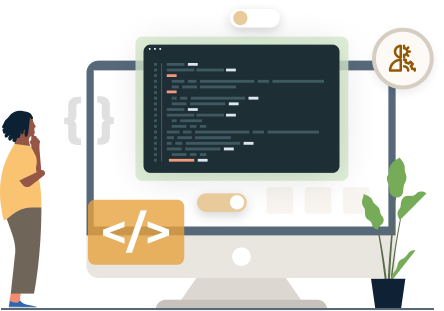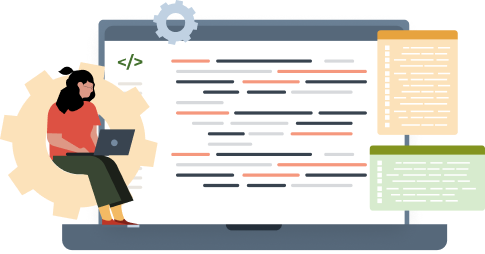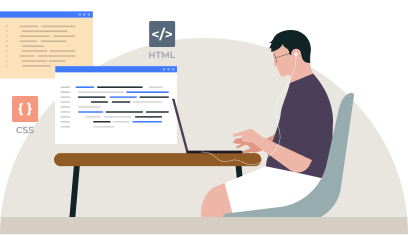
How to Learn Python from Scratch:
Courses & Learning Paths
Explore a skill that’s in high demand industry-wide
Learning Python can give you and your team a competitive advantage in the B2B sector. Whether you're looking to better understand your customers through data analysis, streamline operations, or make smarter decisions, Python offers the tools to get it done efficiently.
Having a team skilled in Python is a practical way to make your business more agile and responsive in a rapidly changing market.

Why Python is in demand
Python has become one of the most widely used programming languages, owing much of its popularity to its versatility and ease of use. According to a Stack Overflow survey, Python is the third most popular programming language among developers. It's not just confined to one industry; it's leveraged across healthcare, finance, and web development, among others.
Industry leaders often emphasize Python's indispensable roles in data analytics, machine learning, and automation. This consistent endorsement from professionals underscores Python's durability and broad relevance.
Python’s relevance for B2B professionals and teams
In a B2B environment, having a team proficient in Python can be a strategic advantage. Python's capacity for data analysis, web development, and automation can streamline operations and provide insightful metrics that inform better business decisions. For example, Python scripts can automate repetitive tasks in data preparation or customer relations, freeing team members to focus on more complex, value-added activities.
Benefits to the organization
The utility of Python extends beyond individual tasks to benefit the organization as a whole. The language's readability and maintainability mean that software projects are often easier to manage and scale. This can result in quicker turn-around times for project delivery and can also make it easier to onboard new team members. Additionally, Python's extensive libraries and frameworks can help to simplify complex tasks, making innovative projects more feasible.
A step-by-step guide to learning Python from scratch
These LinkedIn Learning courses can help guide your team through every stage of their Python journey.
Learning the basics
Starting with the basics is essential for building a strong foundation in Python. At this level, focus on understanding variables, data types, and basic syntax. This will form the building blocks for more complex coding tasks down the line.
Learning Python with Joe Marini
This course covers essential topics ranging from installation and basic Python syntax to practical applications like working with dates, reading and writing files, and web data retrieval in HTML, JSON, and XML formats. This course features interactive Code Challenges with real-time feedback, allowing students to practice coding alongside the course material to enhance their programming skills.
Python Essential Training with Ryan Mitchell
This course covers a wide range of topics, from installing Python and understanding its basic syntax to exploring variables, operators, data types, and data structures. It also includes advanced subjects such as error handling, threading, and working with files, providing a deep dive into both the basics and an introduction to the more complex aspects of Python programming.
Python Quick Start with Lavanya Vijayan
This beginner-friendly course led by Python expert Lavanya Vijayan teaches critical programming fundamentals like data handling, functions, sequences, and control structures such as conditional statements and loops. Lavanya also introduces object-oriented programming and its applications, ensuring that by the end of the course, your team will have a robust understanding of Python.
Moving to Intermediate Topics
Once your team has a handle on the basics, the next step involves diving into intermediate topics like file handling, libraries, frameworks, and web scraping. These skills enable the manipulation of data, working on larger projects, and even interacting with the web.
Learning the Python 3 Standard Library with Kathryn Hodge
In this Python 3 course led by Kathryn Hodge, students explore the Python standard library to improve coding efficiency and ease frustration. The course covers topics such as built-in functions, math modules, and input/output modules, as well as more advanced topics like using the HTTP module to fetch internet data. Alongside these, learners will also discover practical skills like working with operators, using mathematical functions, reading command-line arguments, and handling dates and times.
Python Data Analysis with Michele Vallisneri
Instructor Michele Vallisneri guides students through the practical aspects of data science using Python. Starting with setting up the analysis environment and a review of Python data structures, the course then delves into more advanced topics such as using NumPy for weather pattern analysis and pandas for studying the popularity of baby names over time. With challenges issued throughout the course for hands-on practice, and updates to reflect changes in Python 3, NumPy, and pandas, this course aims to provide a comprehensive introduction to data science with Python.
Web Scraping with Python with Ryan Mitchell
In this course, instructor Ryan Mitchell focuses on the practice of web scraping using Python. She starts by contrasting how humans browse the web compared to web scrapers and introduces essential tools like Chrome developer tools and the Scrapy library. The course covers everything from basic "Hello, World" code for web scraping to advanced topics like using Scrapy's LinkExtractor, working with APIs, and integrating Selenium for browser automation. Alongside these technical skills, Ryan also emphasizes best practices for project organization and future-proofing your team’s web scraping endeavors.
Tackling Advanced Concepts
After mastering intermediate skills, your team is ready to explore advanced topics like machine learning, data visualization, and working with APIs. These are specialized skills that can make anyone invaluable in roles related to data science, machine learning engineering, or back-end web development.
Advanced Python with Joe Marini
This advanced Python course led by instructor Joe Marini aims to help learners master the language's more complex functionalities to enhance application development skills. The curriculum covers a wide range of topics, including object-oriented special class methods, performance tracking through logging, and code portability between Python 2 and 3. With a focus on writing optimized and maintainable code, the course also explores advanced Python features like iterators, transforms, and comprehensions, equipping learners with the skills needed for sophisticated Python programming.
Python for Data Science Tips, Tricks, and Techniques with Ben Sullins
In this course, instructor Ben Sullins focuses on enhancing Python skills specifically for data science applications. The curriculum provides tips and tricks for working with various data formats such as JSON, CSV, and Parquet files. It also guides learners through data manipulation and aggregation techniques using pandas and teaches visualization skills using both basic charts and more advanced features in Plotly, ultimately enriching your team’s data science capabilities.
Level Up: Advanced Python with Jonathan Fernandes
This course, led by data science consultant Jonathan Fernandes, is designed to elevate your team’s Python coding skills to an advanced level. It offers integrated Python coding challenges to test the learner’s grasp of complex concepts and teaches how to write production-level code that's clean, effective, and dynamic. The course is integrated with GitHub Codespaces, allowing for a convenient, cloud-based developer environment for hands-on practice, and features at least 15 bite-sized practice opportunities to reinforce learning at varying levels of difficulty.
For a deep dive into Python, explore the Getting Started with Python Learning Path.






